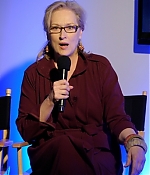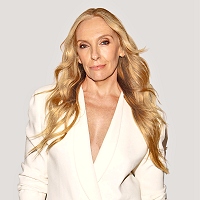|
Simply Streep is your premiere online resource on Meryl Streep's work on film, television and in the theatre - a career that has won her acclaim to be one of the world's greatest living actresses. Created in 1999, Simply Streep has built an extensive collection over the past 25 years to discover Miss Streep's body of work through thousands of photographs, articles and video clips. Enjoy your stay and check back soon.
|
Meryl Streep and Phyllida Lloyd participated in the Meet The Filmmakers series at the Apple Store SoHo to talk about “The Iron Lady”, moderated by Rolling Stone’s Peter Travers. Lloyd tells that the film was offered to her with Streep in mind for the leading role. Lloyd had reservations at first. “She was the most controversial woman in England. The second most controversial thing would be to cast an American actress to play her.” It would have been like cast and English actress to play Hilary Clinton – to which Streep later reminded everyone of Emma Thompson playing Clinton in Mike Nichols’ “Primary Colors”. Streep also tells she has had apprehention as well in the beginning. Surprisingly, she also reveals her discontent with how “The Iron Lady” was promoted through the trailer and promotion for its theatrical release. “The movie is very much more nuanced than we allow it be in its marketing. And it makes me mad when I see it. I get mad with a smile.” The half hour conversation focused on the making of the film in London while several scenes from the film were shown. After showing a scene of Thatcher being put into her place in parliament, Streep said: “In England, there are two ways to look at Margaret Thatcher. One, that she completely dismantled England. And on the other side that she was saintly, that she saved the nation and ushered in prosperity. One side, she’s a monster. Really smart, interesting people. To them, she is just that, there is no other way to look at her. Other people think she saved the economy. But there’s no middle ground. It’s really very difficult to ask people to look at a movie that considers the idea that Margaret Thatcher maybe was a human being. And that’s what interested me”, Streep concluded.
On Margaret Thatcher: This audience doesn’t know that this was the Margaret Thatcher that then set about to make herself more palatable. Her ridiculous hat disappears. Her voice has been lowered. She goes to a speech teacher at the Royal Academy of Dramatic Art. She sort of takes acting lessons to fulfill the role of a leader and to make people comfortable with the idea of a woman leader. Which they were not. That was the beginning. I remember in 1979 how the world was when she was elected Prime Minister, and I didn’t agree with anything that she stood for policitally. But I was secretly thrilled because she was the first female leader of a Western country.

















